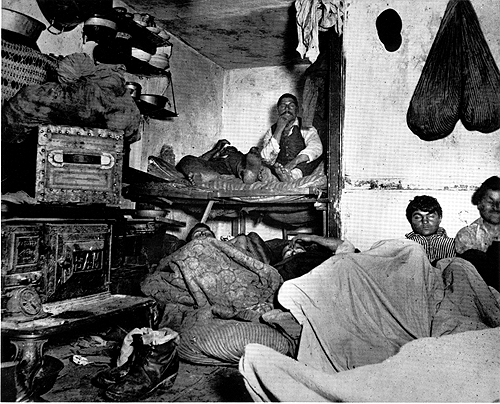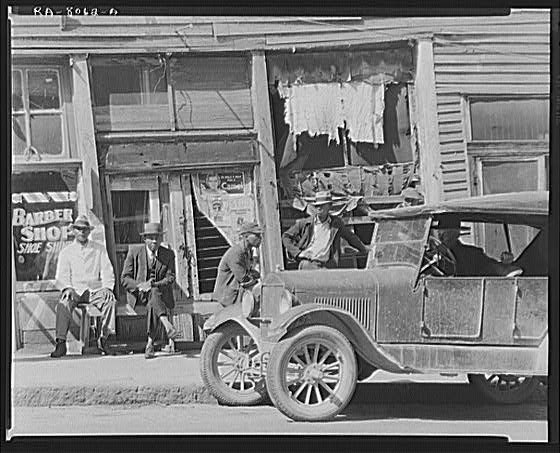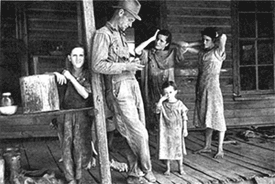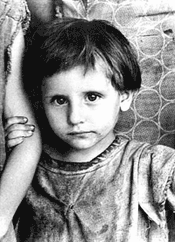talking history | syllabi | students | teachers | puzzle | about us
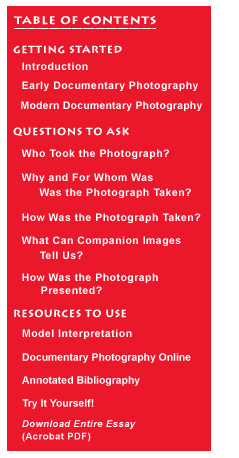
|
 |
|
|
In the modern era of digital imagery and motor driven cameras, it is easy to forget that photographers like Jacob Riis and Lewis Hine operated with equipment that imposed constraints on their actions and their ability to craft a candid scene. To gain access to the alleyway in Bandit’s Roost, for example, Riis had to command his subjects to be still lest stray motion ruin his photograph. Perhaps he negotiated with the alley dwellers himself; more likely he relied on his companions to help set the scene while he unpacked and set up his camera equipment. Riis’ famous after dark photographs required even more planning and preparation. To capture the dim tenement interiors that so shocked his audience, he employed a new flash powder, which resulted in the often startled expressions of the people he photographed and the depiction of interiors with harsh lights and shadows that may have exaggerated their actual appearance. Riis took the image below in a crowded tenement room where single males paid Five Cents a Spot for a night’s lodging. Riis entered this space with the help of the landlord, who received assurances that he would not be prosecuted for running an illegal-lodging house. Riis also needed the cooperation of the sleeping subjects, who had to appear to be awakened by his flash. In order to create that appearance, Riis had to have them pose with their faces toward the camera and then hold still while he ignited his flash powder and made the exposure. Jacob Riis, Five Cents Lodging, Bayard
Street, c. 1889 Even with subsequent advances in film speed and camera technology, documentary photographers of the 1930s continued to direct the actions of their subjects, although they steadfastly denied doing so. Walker Evans was the most outspoken of the FSA photographers in his renunciation of any arrangements prior to exposure. Yet Evans’s camera of choice was a bulky 8X10 view camera that had to be mounted on a tripod. Like Riis, he needed the cooperation of his subjects, who agreed to remain motionless while he made the exposure. If they moved, they would blur the image. Evans chose the large view camera because he could make prints directly from the 8X10 negatives and therefore achieve sharp focus throughout the photographic frame. Historians and art critics have long praised Evans’s photography for its clarity and precision without recognizing the ways in which his reliance on large format photography necessitated the very arrangements he would later denounce. In this 1936 picture of African-American men in front of a Vicksburg, Virginia, barbershop, Evans arranged his subjects so that they appear to be unaware of his presence. One of the males seated on the bench is turned at right angles to the Walker Evans, 1936 to the camera. By posing his subjects in this way, Evans suggests that this is a candid, unposed image. Yet the picture is a product of the large view camera. Evans had to set up his tripod across the street and had to wait for a break in street traffic or stop the flow of traffic altogether. Evans achieved his goal, and critics praised this image as a candid presentation of a sidewalk gathering in the black section of Vicksburg. When we compare the image to companion photographs Evans took the same day, it further suggests that the photographer might have directed the positions and poses of his subjects, since the same men appear in five different compositions. In one alternate view, there are four men on the bench. The new arrival is actually a white man (second from the left of the bench), who may have been seated in the automobile in the previous image. Viewed by itself, this photograph suggests a degree of interracial harmony in Vicksburg. As for the white man, he may have been Evans’s tour guide, in which case his insertion is actually an act of dominion, one which the black men are powerless to resist.
Walker Evans, 1936
These two photographs were taken by Walker Evans at the same rural Alabama household in 1936. The photo on the left was taken with a small, hand-held 35 mm camera; the photo on the right was taken with a large, bulky “view camera” that required long exposure times. Evans often began a photo session by using the 35 mm camera in order to put his subjects at ease. He then took more formal portraits with the larger view camera, which provided greater detail but also required subjects to carefully hold their poses. Evans preferred the results of the view camera, because it gave him more control over the message conveyed by the final photographic image. Now, examine these three different photographs of the same subject. |
||

|
||

